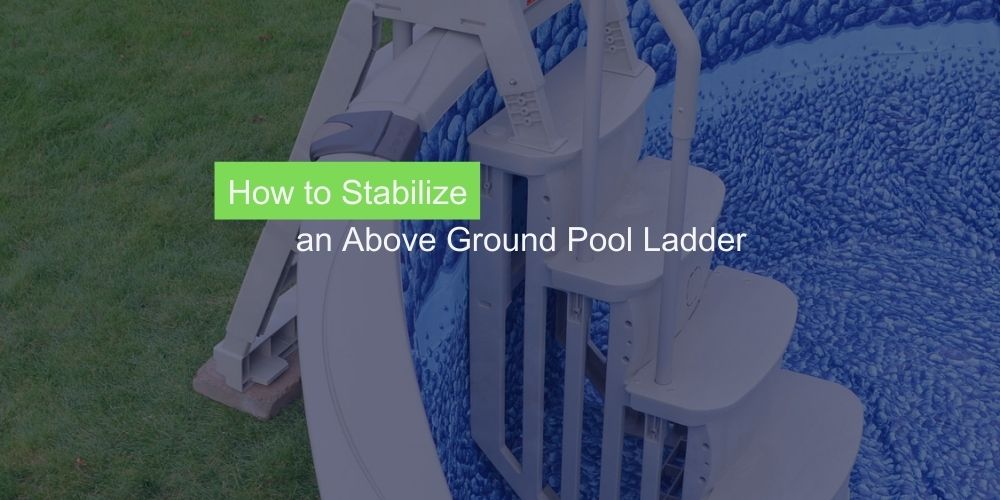
Having an above-ground pool is a wonderful addition to any backyard. It provides a refreshing escape from the summer heat and offers endless hours of fun and relaxation.
One important component of an above-ground pool is the ladder, which allows easy access in and out of the pool. However, it’s not uncommon for above-ground pool ladders to become unstable over time.
This article will explore effective methods to stabilize an above-ground pool ladder, ensuring all swimmers’ safety and peace of mind.
6 Easy Steps to Stabilize an Above-Ground Pool Ladder

1. Assess the Ladder’s Stability
Assessing the stability of your above-ground pool ladder is an essential first step in ensuring a safe swimming environment. By carefully examining the ladder, you can identify potential issues and take appropriate measures to stabilize them.
To begin, inspect the ladder for any signs of wobbling or instability. Give it a gentle shake to see if it feels secure or if there is any noticeable movement. If the ladder feels unstable or unsafe, it’s crucial to address the issue promptly.
2. Inspect and Tighten Bolts and Nuts
Next, examine the bolts and nuts that hold the ladder together. Over time, these fasteners can loosen, compromising the ladder’s stability. Using the appropriate tools, check each bolt and nut to ensure they are tightened securely. If any are loose, pull them carefully but firmly, being cautious not to overtighten and risk damaging the ladder.
3. Adding Non-Slip Pads or Grips
In addition to securing the fasteners, consider adding non-slip pads or grips to the ladder steps. These can greatly enhance safety by providing better traction and stability while climbing in and out of the pool. Non-slip pads are typically made of durable materials designed to withstand exposure to water and provide a secure footing.
4. Install Ladder Stabilizers
Another option to stabilize an above-ground pool ladder is to install ladder stabilizers. These devices are designed to reinforce the ladder’s stability and minimize wobbling or shifting. They often attach to the sides of the pool and provide additional support and security.
5. Secure the Base of the Ladder
Securing the base of the ladder is also essential for stability. Consider using anchor weights or sandbags placed around the bottom to prevent movement. These weights add strength and help keep the ladder in place, especially during pool use.
6. Use Weighted Sandbags
Weighted sandbags can be an effective solution for stabilizing the ladder. They can be strategically placed around the ladder base to add weight and prevent shifting. Ensure that the sandbags are distributed evenly and securely to maintain stability.
8. Regular Maintenance Tips
Lastly, it’s important to prioritize regular maintenance for your pool ladder. Perform periodic inspections to check for any signs of wear and tear, loose connections, or other issues. Clean the ladder regularly and address any necessary repairs promptly to ensure its long-term stability and safety.
How do you anchor a pool ladder?
To anchor a pool ladder, you can follow these general steps:
- Determine the desired location: Decide where you want to place the pool ladder in your pool. Make sure it is convenient and accessible.
- Measure and mark the location: Use a tape measure to determine the correct distance from the pool’s edge and keep the location where the ladder will be installed.
- Prepare the anchor sockets: If your pool has built-in anchor sockets, ensure they are clean and free from any debris or obstructions. If not, you may need to install anchor sockets following the manufacturer’s instructions.
- Insert the ladder into the anchor sockets: If your ladder has removable sections, assemble it according to the manufacturer’s instructions. Then, carefully slide the ladder sections into the anchor sockets until they are securely placed.
- Test the stability: Apply downward pressure on the ladder to check if it feels stable and secure. Ensure that it does not wobble or move excessively. If necessary, adjust the ladder or anchor sockets to improve stability.
- Lock the ladder in place: Depending on your type of ladder, there may be additional steps to secure it. Some ladders have locking mechanisms or pins that must be engaged to prevent accidental dislodgment.
- Follow the manufacturer’s instructions: Always refer to the specific instructions provided by the manufacturer of your pool ladder for detailed guidance on installation, maintenance, and any additional anchoring requirements.
How are pool ladders secured?
Pool ladders are secured in different ways depending on their design and the type of pool they are being used with. Here are some common methods of obtaining pool ladders:
- Anchor Sockets: Many pool ladders have removable sections that slide into anchor sockets installed in the pool deck or coping. The anchor sockets have a sleeve or opening that securely holds the ladder. The ladder sections can be easily removed when not in use.
- Bolts or Fasteners: Some pool ladders have metal brackets or plates with pre-drilled holes that can be bolted or fastened directly to the pool deck or coping. This method provides a more permanent and fixed installation.
- Weighted Bases: Certain pool ladders, particularly those used with above-ground pools, feature weighted bases on the pool floor. The weight of the bottom keeps the ladder stable and prevents it from tipping over. These types of ladders do not require any additional anchoring.
- Clamp Systems: In certain cases, pool ladders may use clamp systems that attach to the pool wall or railing. The clamps provide a secure attachment point and keep the ladder in place.
- Locking Mechanisms: Some pool ladders have lock mechanisms or pins to help secure the ladder. These mechanisms are typically engaged after the ladder is inserted into anchor sockets or attached to the pool structure.
Final Words
Ensuring the stability of your above ground pool ladder is of utmost importance for a safe and enjoyable swimming experience. By implementing the methods discussed in this article, such as securing the base, anchoring to the pool deck, adding additional support, and conducting regular maintenance, you can significantly enhance the stability of your pool ladder.
Remember to inspect your ladder regularly and promptly address any signs of wear or damage. By taking these measures, you can have peace of mind knowing that your above ground pool ladder is secure, providing a reliable means of entry and exit for swimmers. Enjoy your pool time with confidence and safety!

Hi, This is Josh. I am a former competitive swimmer and current fitness enthusiast.
I created this site to share my love of swimming with the world!

